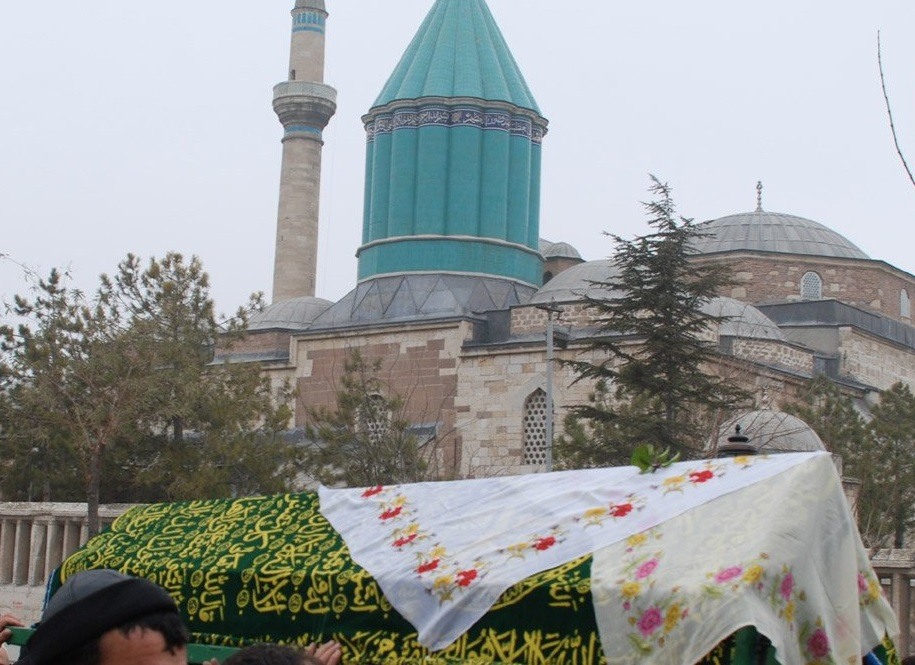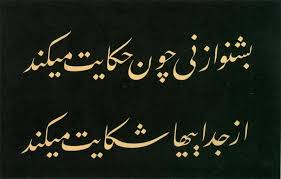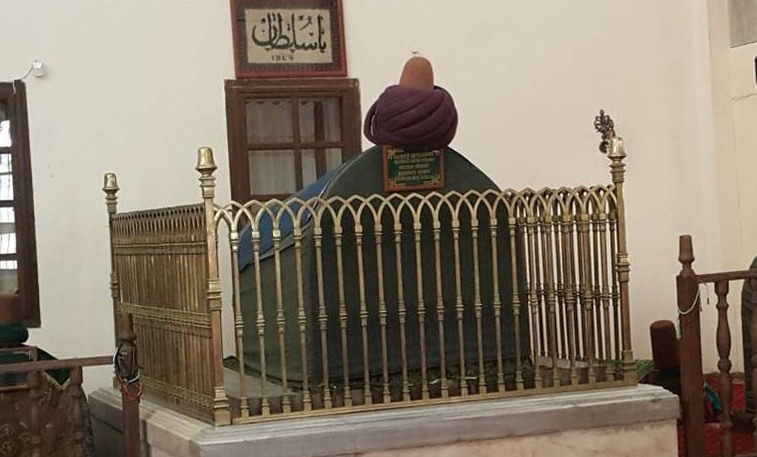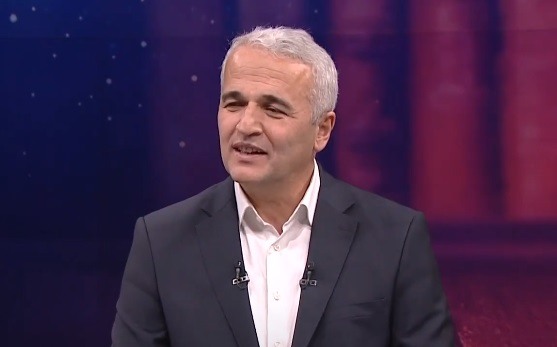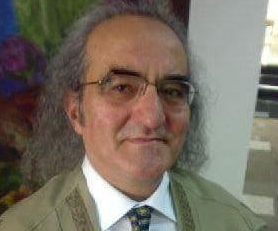HÜSN Ü AŞK’IN KİMYASI
HÜSN Ü AŞK’IN KİMYASI
THE ALCHEMY OF HUSN U ASHK
Ahmet DOĞAN *
ÖZ
Hüsn ü Aşk, Şeyh Galip’in (öl. 1799) kendi ifadesiyle “esrârını Mesnevi’den aldı[ğı]” tasavvufi-sembolik bir eserdir. Galip, “mîrî malı” olarak değerlendirdiği Mesnevi’den kendisine uzanan Mevleviliğin ve bütün bir tasavvufi geleneğin sembol hâline dönüşen imgeleriyle kendi özgün hayallerini ustaca yoğurduğu Hüsn ü Aşk’ında, esas olarak insanın “kemal”e uzanan yolculuğunu tahkiye eder. Hüsn ü Aşk’taki sembolik dönüş[üm] yolculuğu, esere ismini veren kahramanlardan Aşk’ın, Hüsn’e talip olmasının ardından kendisine sunulan, “diyar-ı kalb”den “kimya”nın getirilmesi şartını kabul etmesiyle başlar. Hüsn’e kavuşması için Aşk’ın bulması gereken “kimya”, insanoğlunun ezelî hayali olan altın elde etme çabalarına aracılık eden maddi/deneysel bir araç olmaktan çok, tinsel (manevi, ruhsal) bir dönüşümün vasıtası olarak kullanılmıştır. Geliştiği her kültürde ezoterik (içrek, bâtıni) düşünceyle yakın ilişkisi olan kimya, tüm mistik geleneklerde olduğu gibi sufizmde de manevi bir dönüşümün simgesi olarak alımlanmış ve sufilerce asıl kimya, kalplerin dönüşümü olarak düşünülmüştür. Kimyanın madde dediği şey, “geleneksel benlik” (sıradan insan); onun iksir aracılığıyla dönüştüğü altın, “evrensel benlik” (kâmil insan) ve iksir de (kibrit-i ahmer) gönülleri altına çeviren ermişlerin nazarı olarak değerlendirilmiştir. Hüsn ü Aşk mesnevisinde de Aşk’a, sevdiğine kavuşması için öncelikle “kimya”yı getirmesinin şart koşulması, “kimya”nın dönüşümün simgesi olmasından kaynaklanır. Aşk’ın, Hüsn’e biçilen pahayı bulmak üzere kalp diyarına yaptığı yolculuk neticesinde elde ettiği “kimya”, aslında yolun bizzat kendisi olur ve onu Hüsn eyler.
Anahtar Kelimeler: Şeyh Galip, Hüsn ü Aşk, Yolculuk, Kimya
ABSTRACT
Husn u Ashk (Beauty and Love) is a sufi-symbolic work that Sheikh Ghalib, in his own words, “received his secret from Mathnawi”. Sheikh Ghalib used the symbols of Mawlana Jalâl ad-Dîn Rûmî’s Mathnawi and Sufi tradition, which he called “mîrî good” in his Husn u Ashk. Sheikh Ghalib, who skillfully combined his own original dreams with these symbols and images, in his Husn u Ashk, mainly told the story of the journey of man to ripeness. The symbolic transformation journey in Husn u Ashk begins when Ashk (Love), one of the heroes who gave the work its name, agrees to bring “alchemy” from the “diyar-ı kalb” that was stipulated to him after he aspired to Husn (Beauty). The “alchemy” that Ashk must bring to Husn to reach her is not a material tool that humanity has dreamed of since ancient times, interested in turning worthless mines into gold. The alchemy here has been used as a means of spiritual transformation. Alchemy, which has a close relationship with esoteric thought in every culture in which it develops, has been adopted as a symbol of spiritual transformation in Sufism as in all mystical traditions. According to the Sufis, the actual alchemy was the transformation of hearts. The equivalent of matter in Chemical Science is the “conventional self”. The Philosopher’s stone that turns a substance into gold is the glance of sheiks. The resulting gold was evaluated as the perfect human. In Husn u Ashk mathnawi, Ashk was asked to bring “alchemy” to reach his loved one, because “alchemy” is the symbol of transformation. Ashk’s journey to bring alchemy is alchemy itself.
Keywords: Sheikh Ghalib, Husn u Ashk (Beauty and Love), Journey, Alchemy
Extended Abstract
Husn u Ashk (Beauty and Love) is a mystical, symbolic mathnawi of 2041 distich written by Sheikh Ghalib in 1197 (Gregorian 1783). It is an excellent work that reflects Ghalib’s innovative spirit. According to Ziya Pasha, Sheikh Ghalib seems to have been born to write for Husn u Ashk. Husn u Ashk (Beauty and Love) has taken a unique place in classical Turkish literature thanks to its excellence in discourse and originality in fiction. With Husn u Ashk, Sheik Ghalib transformed the Turkish mathnawi tradition, which takes the Nizâmî-i Gencevî as an example and he put his stamp on the history of literature as a genius.
Sheikh Ghalib, who took the inspiration of Husn u Ashk (Beauty and Love) from Mawlana Jalâl ad-Dîn Rûmî’s Mathnawi, describes a mystical inner journey in his work, in which he makes intensive use of the symbols of the Sufi tradition in which he resides. According to the Dervish Esrar Dede who suffered (be a dervish) under the supervision of Ghalib, Husn u Ashk contains of the secrets of the inner journey in Mevlevi. In Husn u Ashk, almost everything such as “Benî Mahabbet”, “Mollâ-yı Cünûn”, “Sühan”, “Gayret”, “Hayret”, “hisâr-ı kalb”, “çeh” especially the heroes who gave the work its name, comes to the fore in the symbolic sense. One of the Sufi symbols that Ghalib has cost himself in his work is “alchemy”.
Alchemy is referred to as the wedding price that the “Benî Mahabbet” tribe wanted after Ashk (Love), one of the heroes who gave the Mathnawi its name, aspired to Husn (Beauty). The tribal elders who advise Ashk, who wants Husn, that there can be no effortless treasure mehr” (dowry price); they say that Husn expresses priceless value, that his “mehr” (dowry price) will be accordingly, and that he must bring alchemy to reach him. The ‘alchemy’ that the tribesmen require from Ashk to bring him from the “diyâr-ı kalb” (land of the heart) is the symbol of transformation. Alchemy, which has mediated humanity’s dreams of obtaining gold since time immemorial, has been used as an experimental tool. It has also been seen as a universal elixir of healing and immortality. The work of turning worthless substances in alchemy into gold, the most valuable substance on Earth, has been associated with the discovery of the divine essence in man. In this context, it has been stated that the most basic element of transformation in alchemy and the effective substance known as the potion or philosopher’s stone is the heart of man or himself.
Alchemy, which is to purify the polluted soul of Man and return it to its first state, and in this aspect is of a purely spiritual nature, has been called “alchemy of felicity” in the Islamic world. What alchemy calls matter is the ‘traditional self’; the gold he turns into through the potion is also a competent person (perfect human). In Husn u Ashk (Beauty and Love), Ashk is told that he must go on a difficult journey to the “land of the heart” to find alchemy, as the real alchemy is the transformation of hearts.
The heart, which is the center of mystical consciousness and is a power that allows man to open up to the order above the senses, is the place of change and transformation. Since the heart is the only place where a person will find an entire world in his eternity and know his “own”, Ashk does not need to fall into the deserts like Mecnun. The seas, mountains, deserts, etc. obstacles that he must overcome to mature are not outside, but inside, deep in his heart. To reach Husn, Ashk must first go to land of the heart (diyâr-ı kalb), where there are very big troubles on his way, and bring alchemy from there. Ashk will complete himself by facing the forces and difficulties that try to distract him from his path as he moves through his spiritual depths during his journey to the castle of the heart. According to Mevlana, the danger of a path to the treasure is directly proportional to the value of the treasure. Therefore, Ashk suffers great difficulties on his journey in the land of the heart (diyâr-ı kalb), which he went out to meet Husn. A thousand-headed snake with embroidered skin, candle ships floating in a sea of fire, the ruins of gamut, the palace of mourning, giants, fairies, wild animals and witches are just some of the scourges waiting for Ashk during the journey.
Like mines that undergo different processes in alchemy and undergo the treatment of fire by waiting, Ashk is also purified by the ordeal it has suffered throughout the journey. Ashk overcomes the dangers it faces during its journey only with the help of “Suhan” (logos, word). A guide, Suhan, has the property of elixir (philosopher’s stone), which is the effective substance of the alchemical process.
Ashk, who enters the “land of the heart” under the guidance of Suhan, finds everyone and everything before the journey here. Ashk realizes that Husn and himself are the same in “castle of the heart”, which he enters in hopes of finding “alchemy”. Ashk completes its transformation by finding maturity as a result of this journey, which is his personal alchemy and achieves an “absolute” serenity with Husn.
Giriş
Klasik Türk şiirinin son büyük temsilcisi olduğu hususunda hemen tüm kaynakların ittifak ettikleri ve bu bağlamda kendisinden övgüyle bahsettikleri Şeyh Galip, hakkında söylenen övgü dolu sözleri ve şöhretini büyük ölçüde Hüsn ü Aşk mesnevisine borçludur. Bir ikindi güneşine benzeyen ömrüyle Osmanlı şiir semasını son kez aydınlatan Galip, Ziya Paşa’nın eşsiz ifadesiyle; sanki Hüsn ü Aşk’a vücut vermek için cihana gelmiş bir “şâir-i yegâne”dir. Şeyh Galip, eserin “sebeb-i te’lif” (kitabın yazılma sebebine dair) bölümünde ifade ettiği üzere Hüsn ü Aşk’ı, bir şiir meclisinde Nâbî’nin Hayrâbâd’ının aşılamayacağının söylenmesine binaen kaleme almıştır. Hayrâbâd’ı, Feridüddin Attar’dan çalınma bir kıssa olarak değerlendiren Galip, bir hırsıza düzülen methiye olarak değerlendirdiği bu eserin herhangi bir orijinalliğe sahip olmadığını ve dolayısıyla bu kadar fazla övgüyü de hak etmediğini düşünür:
El-hak çalıp alma kıssadır ol
Hırsızlara hayli hissedir ol
Pîrâne tekellüf etmiş elhak
Vermiş hele kâr-ı düzde revnak (208, 209)1
Nâbî’nin olgunluk döneminde yazmış olduğu eserden çıkarılacak olan dersin sadece ‘dünya fânî âhiret bâkî’ gibi ‘harcıâlem’ bir düşünce olduğunu ve bunu işitmedik hiçbir kulak olamayacağını söyleyen Galip, artık farklı bir şeylerin anlatılması gerektiğini iddia eder:
Merd ana denir ki aça nev-râh
Erbâb-ı vukûfı ede âgâh (212)
Sarf ettiği bu iddialı sözleri dolayısıyla meclistekilerce davasını ispata zorlandığında henüz yirmi altı yaşında olan Galip, kendi deyişiyle “çemeni görülmedik bir gül” derlemek arzusuyla “divan yolu”ndan ayrılarak bir “vâdî-i kemîn”e (tuzaklarla dolu yol) yönelir. Şeyh Galip, altı ay kadar süren bu zorlu yolculuktan, yanında paha biçilemez bir hazine olan Hüsn ü Aşk ile döner. Eserini kısa bir zaman zarfında tamamlayarak özgünlüğü üzerine “billâh bu özge mâceradır” diye ant içen Şeyh Galip, Hüsn ü Aşk’ın kısa sürede tamamlanmış olmasının, aceleye getirilmiş anlamına gelmeyeceği noktasında;
Engüşt-i hatâ uzatma öyle
Beş beytine bir nazîre söyle
Az vaktde söyledimse anı
Nâ-puhteligin degil nişânı (2015, 2016)
mısralarıyla okuyucuyu/eleştiriciyi meydan okurcasına uyararak eserine olan inancını vurgular. Eseriyle Türk mesnevi geleneğini dönüştürmeyi başaran Galip, daha evvel ulaşılamamış olan yüksek bir şiir olgunluğuna ulaşmayı da başarmıştır (Bilgegil, 1997: 402; Gibb, 1999 C: IV: 398). Âvîze gibi renk ve ışık dolu (Tanpınar, 1995: 310) olan Hüsn ü Aşk mesnevisinin getirdiği yenilikçi ruhla geleneğin yıpranan yanlarını onaran Şeyh Galip, ‘geçmişi hâl içinde hissettiği kadar geleceği de aynı zaman dilimi içerisinde hissetmek’ (Kantarcıoğlu, 1981: 26) suretiyle hem geleneğin bir devamı olma hem de bütün zamanların okuyucusuna hitap edebilme imkânı bulmuştur. Böylece kendi sesiyle birlikte geleneğin sesini de ötelere taşımaya muvaffak olmuştur.
Şeyh Galip, bu özgün eserin ilhamını Mevlana’nın Mesnevisi’nden almıştır. Kendi kaleminden çıkan Hüsn ü Aşk nüshasının der-kenarına Mesnevi’yi tam dokuz kez okuduğuna dair not düşen (Gölpınarlı, 1968: 15) Şeyh Galip, Hüsn ü Aşk’taki Mevlana’ya övgü bölümünde Mesnevi’den aldığı ilhamı;
Esrârını Mesnevî’den aldım
Çaldım velî mîrî malı çaldım (2019)
Feyz erdi Cenâb-ı Mevlevî’den
Aldım niçe ders Mesnevî’den (2029)
mısralarıyla açıkça dile getirir. Cenâb-ı Mevlevî’nin feyziyle Mesnevi’den nice dersler alan ve başsız ayaksız aşk yollarına düşen Galip, temellük ettiği tasavvufî geleneğin sembolleriyle Hüsn ü Aşk’ında mistik bir iç yolculuğu anlatır. Galip’in nezaretinde çileye soyunan Esrar Dede’nin ifadesiyle (2000: 376) Mesnevi-i Manevi’nin ilhamıyla Mevlevi sülukunun sırlarının anlatıldığı bir şaheser olan Hüsn ü Aşk’ta, esere ismini veren kahramanlar başta olmak üzere Benî Mahabbet, Mollâ-yı Cünûn, Sühan, Gayret, Hayret, hisâr-ı kalb, kuyu, cadı, âh kılıcı gibi hemen her şey sembolik anlamıyla ön plâna çıkar. İçinde bulunduğu geleneğin mensuplarınca fark edilmesi dolayısıyla Galip’in açıklama ve sergileme ihtiyacını en aza indirgeyen bu yoğun simgesel mirastan (Holbrook, 1998: 96) biri de “kimya”dır.
Devamı:…
* Prof. Dr., Ahi Evran Üniversitesi, Fen-Edebiyat Fakültesi, Türk Dili ve Edebiyatı Bölümü, Kırşehir, Türkiye E-mail: ahmetdogan@ahievran.edu.tr
1 Hüsn ü Aşk’tan yapılan alıntılarda [Ece, Selami (2012). Hüsnüne Aşk Olsun, Erzurum: Fenomen Yayınları.] künyeli çalışma esas alınmıştır.


